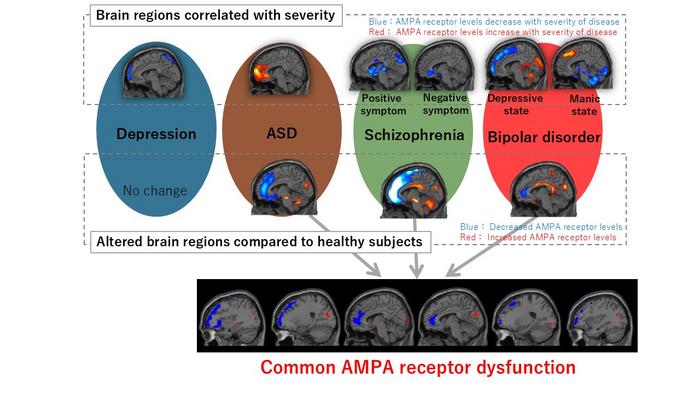Summary: Japanese researchers have developed a revolutionary method to visualize key brain receptors in patients with psychiatric disorders, offering new insights into conditions like schizophrenia and autism. Using advanced imaging technology, the study of 149 patients reveals distinct patterns of receptor distribution that could transform our understanding and treatment of mental health conditions.
Journal: Molecular Psychiatry, October 15, 2024, DOI: 10.1038/s41380-024-02785-1 | Reading time: 6 minutes
For decades, psychiatric disorders have remained mysterious from a biological perspective, despite affecting millions worldwide. While doctors can recognize the symptoms, understanding exactly what happens in the brain has proven elusive – until now.
A Window Into the Brain’s Communication Network
In a groundbreaking study, researchers from Yokohama City University (YCU) and other Japanese institutions have developed a new way to observe crucial components of brain cell communication in living patients. The research team, led by Professor Takuya Takahashi, used positron emission tomography (PET) and a specialized tracer to visualize AMPA receptors – essential molecules that enable communication between neurons.
The study, published in Molecular Psychiatry, examined 149 patients with various psychiatric conditions, offering unprecedented insights into how these disorders manifest in the brain’s physical structure and function.
Distinct Patterns Emerge
The research revealed fascinating differences in how AMPA receptors are distributed across various psychiatric conditions. In autism spectrum disorder (ASD), researchers found increased receptor density throughout most of the cortex, potentially explaining why many patients experience sensory overload.
For schizophrenia, the findings were particularly revealing. The study showed that brain areas associated with different types of symptoms – such as hallucinations versus lack of motivation – didn’t always overlap, suggesting a complex interplay between different brain regions in producing various symptoms.
Implications for Future Treatment
“Identifying both unique and shared brain regions with altered AMPA receptor density offers new insights into the biological mechanisms of psychiatric disorders,” highlights Professor Takahashi in the study. This understanding could revolutionize how we approach treatment.
The research team discovered an intriguing pattern: the brain regions showing differences between healthy and affected individuals (trait regions) were distinct from areas where receptor density correlated with symptom severity (state regions). This finding suggests a complex progression of these disorders that warrants further investigation.
Looking Ahead
“These findings could have a significant impact on the healthcare and pharmaceutical industries by providing a novel method for diagnosing and understanding psychiatric disorders through AMPA receptor imaging,” Professor Takahashi notes. He adds that “It may lead to new targeted therapies and diagnostics based on synaptic function, improving treatment precision and outcomes.”
Glossary:
– AMPA receptors: Key molecular components in brain cells that enable communication between neurons
– Synapses: Connection points between neurons where communication occurs
– PET (Positron Emission Tomography): An imaging technique that uses radioactive tracers to visualize biological processes
– Cortex: The outer layer of the brain involved in higher-order thinking and processing
– Trait regions: Brain areas showing consistent differences between healthy individuals and those with psychiatric conditions
Quiz:
1. What new technology did researchers use to study psychiatric disorders?
Answer: PET scanning with a special tracer called [11C]K-2 to visualize AMPA receptors
2. How many patients were included in the study?
Answer: 149 patients
3. What was a key finding regarding autism spectrum disorder (ASD)?
Answer: ASD showed increased AMPA receptor density throughout most of the cortex
4. What unique observation was made about “trait” versus “state” regions in the brain?
Answer: There was almost no overlap between regions showing general disease traits and those correlating with symptom severity
Enjoy this story? Get our newsletter!
If our reporting has informed or inspired you, please consider making a donation. Every contribution, no matter the size, empowers us to continue delivering accurate, engaging, and trustworthy science and medical news. Independent journalism requires time, effort, and resources—your support ensures we can keep uncovering the stories that matter most to you.
Join us in making knowledge accessible and impactful. Thank you for standing with us!

